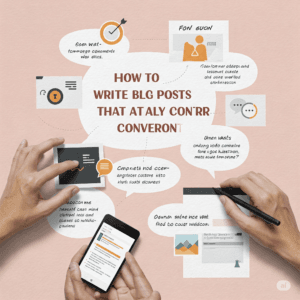How to Write Blog Posts That Actually Convert

Writing blog posts isn’t just about sharing information or telling your story anymore — it’s about driving real action. Whether you want readers to subscribe, buy, sign up, or click, your blog needs to convert visitors into customers, followers, or leads. So, how do you go beyond good writing and create posts that actually convert? Here’s the no-BS blueprint.
1. Start With One Clear Goal (And Keep It Laser Focused)
Conversion happens when your reader knows exactly what you want them to do. Vague posts that try to do everything end up doing nothing. Are you trying to:
Get them to buy a product?
Encourage newsletter sign-ups?
Get social shares?
Drive app downloads?
Pick one goal and write everything around it. Everything — from your headline to your call to action — should funnel toward that single objective. Clarity breeds conversions.
2. Craft Headlines That Promise Value and Stir Curiosity
Your headline is the first (and sometimes last) chance to grab attention. The best converting blog posts start with headlines that are:
Specific (not generic)
Benefit-driven (what’s in it for them?)
Emotionally charged (curiosity, urgency, or excitement)
For example, instead of “How to Write Better Blog Posts,” try “How to Write Blog Posts That Triple Your Email Subscribers in 30 Days.” Notice the promise and timeline? That’s conversion gold.
3. Speak to Your Ideal Reader — Not Everyone
Write as if you’re having a direct conversation with one person. The more you niche down your audience, the more persuasive and personal your content becomes.
Don’t just talk at your readers. Understand their problems, their pain points, and what keeps them up at night. Then, show them how your post (and your solution) answers those burning questions.
4. Use Storytelling to Connect Emotionally
Facts inform. Stories sell.
People remember stories long after they forget statistics. Open your post with a relatable story that mirrors your reader’s struggle, then guide them through your solution. Stories build trust, and trust leads to conversions.
5. Break Down Complex Ideas Into Digestible, Actionable Steps
Your readers don’t want a wall of text or marketing jargon. They want clarity and actionable advice.
Use:
Short paragraphs
Bullet points
Subheadings that guide the eye
Clear examples
Make it easy for your readers to get it and do it — and they’ll be far more likely to convert.
6. Sprinkle Social Proof and Data, But Don’t Overload
Case studies, testimonials, and stats boost credibility and ease doubt. If you say your method works, prove it with real results or quotes from happy customers.
But don’t overdo it. Too many numbers or quotes can distract. Use social proof like seasoning — enough to enhance the flavor, not overpower it.
7. End With a Strong, Clear Call to Action
Don’t leave your readers guessing what to do next. Be bold and direct.
Want them to sign up? Say, “Join 10,000 others and get weekly tips straight to your inbox.”
Want a purchase? “Click here to grab your exclusive discount now.”
Want shares? “If this helped, share it with your friends!”
Make your CTA impossible to miss — and make the next step easy.
Bonus Pro Tip: Test, Tweak, Repeat
Conversion is a science and an art. Don’t expect perfection on your first try. Use analytics and heatmaps to see where readers drop off or click, then tweak headlines, CTAs, or copy to improve.
Bottom line: Writing blog posts that convert isn’t magic — it’s strategic, focused, and reader-first. Nail these essentials, and you’ll turn casual browsers into loyal customers.
Now, what’s your next blog post going to convert on?
